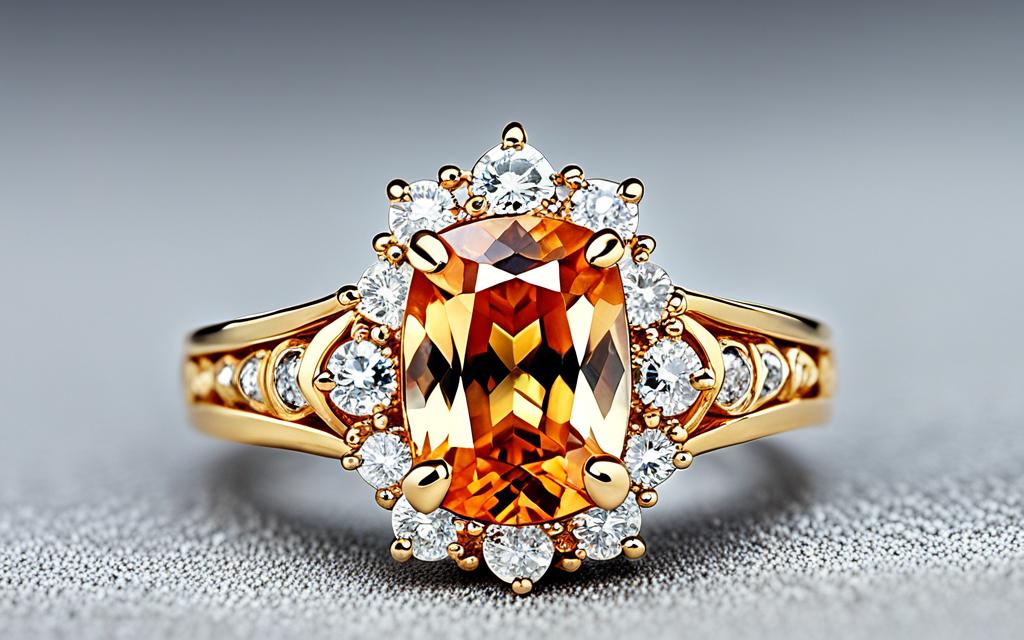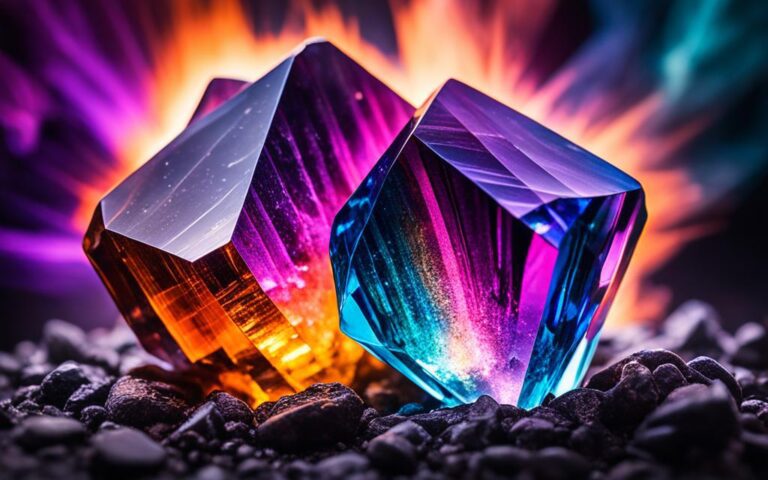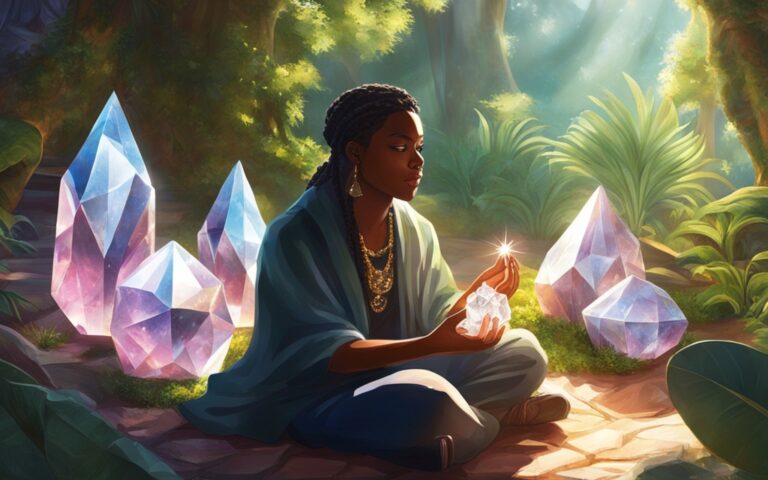Imperial Topaz: Rare Gem of Royalty and Luxury
AfricaGems.com has over 100 imperial topaz gemstones. They come in many shapes, sizes, and prices. This rare topaz gemstone is very sought after, especially in large sizes. It has a rich history tied to royalty and luxury. People love it for its beautiful colors and clearness.
Key Takeaways
- Imperial topaz is a rare and highly prized variety of topaz gemstone known for its reddish-orange to pink colors.
- It has a long history with connections to Russian royalty and a reputation for luxury and exclusivity.
- Imperial topaz is renowned for its exceptional clarity and beauty, making it a highly sought-after gemstone for fine jewelry.
- The largest raw imperial topaz found in Brazil weighed an astonishing 597 pounds.
- Imperial topaz is the traditional birthstone for those born in November and the Zodiac birthstone for Sagittarius.
What is Imperial Topaz?
The definition of imperial topaz is about a special type of topaz gemstone. It’s known for its bright reddish-orange to pink colors. These colors make imperial topaz unique, setting it apart from other topaz types. It’s seen as a gemstone of royalty and luxury.
Definition and Characteristics
Imperial topaz is an allochromatic gemstone. This means its colors come from tiny impurities and defects, not its basic makeup. It has a hardness of 8 on the Mohs scale, a refractive index of 1.609 – 1.643, and a relative density of 3.49 – 3.57.
Historical Background and Discovery
The story of imperial topaz began in the 19th century in Russia. It was first found in the Ural Mountains. The stone’s reddish-orange color led to its name, honoring the Russian Tsars who claimed it.
Before this, topaz was known for centuries. But the specific imperial topaz type wasn’t recognized until its discovery in the Urals.
“Imperial Topaz is a gemstone of royalty and luxury, captivating the world with its rare and desirable colors.”
The Regal Origins of Imperial Topaz
In the 19th century, imperial topaz became linked with Russian royalty. This happened when large amounts of this rare gemstone were found in the Ural Mountains. The Russian Tsars then made a rule. They said they owned all imperial topaz in the Russian Empire.
This rule made imperial topaz a symbol of luxury and high status. The imperial topaz from the Ural Mountains was famous for its deep orange to rich yellow colors. These colors came from the area’s unique mix of heat and pressure.
“Imperial topaz is a rare and sought-after variety of topaz, known for its deep orange to rich yellow hues.”
The Russian nobility loved this gemstone even more, making imperial topaz a symbol of power and refined taste. Its link to the Russian Empire has lasted for centuries. This has made it a highly desired gem in the world of fine jewelry and gemstones.
Connection to Russian Royalty
The finding of imperial topaz in the Ural Mountains in the 19th century was a big deal. The Russian Tsars saw how rare and beautiful it was. They took full control of it.
This move made imperial topaz a gem of the highest class. It was only for the royal family and their most precious things. The imperial topaz became a symbol of Russian royalty’s power and wealth.
The imperial topaz from the Ural Mountains was especially loved for its intense orange-yellow colors. These colors showed the warmth and luxury of the Russian Empire. This made the gemstone even more popular among the elite and fine jewelry collectors.
Mesmerizing Colors and Varieties
Imperial topaz is known for its wide range of colors, from deep reddish-orange to soft pinkish tones. The most sought-after imperial topaz has a bright, deep reddish-orange color, often called “sherry” or “cognac”. But, it can also be found in golden yellow, peach, and even pinkish shades.
The unique colors of imperial topaz come from its special chemical makeup and structure. Each gem is like a piece of natural art. The colors of imperial topaz vary, with clarity, cut, and weight affecting their value and rarity.
Shades of Yellow, Orange, and Red
The most famous imperial topaz is the reddish-orange type. But, it also comes in yellow and orange shades. Yellow imperial topaz can be light lemon or deep golden brown, thanks to iron.
Orange imperial topaz shows colors from peach to a bright, fiery orange. The red imperial topaz is the rarest and most valuable, with colors from pale pink to deep, blood-red. This color comes from iron or manganese in the stone.
“Imperial topaz is characterized by captivating hues ranging from deep golden orange to vibrant pinkish-red.”
Imperial Topaz: Rare Gem of Royalty and Luxury
Imperial topaz is one of the rarest and most valuable gemstones globally. It’s closely linked to Russian royalty and is hard to mine and produce in high quality. This makes it a gem of luxury and exclusivity.
The gem’s exceptional clarity, vivid colors, and scarcity make it highly sought after. Collectors and connoisseurs love it for these reasons.
Also known as “precious topaz,” it’s more expensive than other topaz types. It comes in beautiful colors like peachy pink, which are highly prized. Mystic topaz, on the other hand, is coated with a thin film for a rainbow effect. But it can’t match the natural beauty and rarity of Imperial Topaz.
Imperial Topaz is seen as a gem fit for royalty. Its link to Russian nobility and the challenges in mining high-quality stones add to its luxury status. Its exceptional clarity, vivid colors, and scarcity make it a treasure sought by collectors worldwide.
“Imperial Topaz is a true gem of royalty, a treasure that whispers of elegance and exclusivity.”
Physical Properties and Formation
Imperial Topaz is a gemstone known for its unique physical traits and how it forms in the Earth. It’s made of aluminum, silicon, and oxygen. Its chemical formula is Al2SiO4(F,OH)2. This makes it a gem of nature’s creativity.
Crystal Structure and Composition
Topaz, including imperial, crystallizes in a rhombic structure. This leads to well-formed, elongated crystals. The specific mix of elements needed for its creation makes the imperial topaz’s crystal structure and composition rare and sought after.
Hardness and Optical Properties
Imperial topaz has a hardness of 8 on the Mohs scale. This makes it durable for jewelry. Its clarity and luster are highly valued optical properties. These enhance its beauty and make it a valuable gemstone.
The stone’s ability to split white light into colors is called pleochroism. This adds to its enchanting nature.
“The unique combination of elements and the precise environmental factors required for Imperial Topaz’s formation contribute to its rarity and desirability.”
Mining Locations and Sources
Brazilian Imperial Topaz
The Ouro Preto region in Brazil is famous for its imperial topaz. This area in Minas Gerais has been the main source of this gem since the 1700s. It was first found in the region’s alluvial deposits.
Brazilian imperial topaz is known for its bright colors. It has reddish-orange and pink hues that are loved by collectors and jewelry fans. Mining in Minas Gerais started in the mid-1700s. The region is known for producing some of the best imperial topaz crystals.
The main mines for topaz are at the Vermelhão and Capão mines. These mines are near Ouro Preto and between Dom Bosco and Rodrigo Silva. Mining started in the early 1800s. Topaz is found in cavities or in kaolinite veins in weathered rocks.
This has led to a debate among geologists for over two centuries. But, the region has significant topaz deposits along faults. These faults helped bring mineral-rich fluids from deep rocks to the surface, creating these amazing crystals.
Ouro Prêto is the top source of golden topaz in the world. Gem shops in Ouro Prêto, Belo Horizonte, Rio de Janeiro, and Sao Paulo offer many topaz crystals. These crystals are as beautiful as those found years ago. The topaz mining in the area is booming, showing great hope for the future.
Metaphysical and Spiritual Significance
Throughout history, topaz, especially the regal Imperial type, has been filled with spiritual and metaphysical meanings. In ancient Greece, it was thought to give strength and the power to become invisible. In India, Imperial Topaz was seen to bring beauty, intelligence, and a long life to its owner.
During the Renaissance, people wore topaz to protect against spells and calm anger. Today, Imperial Topaz is still believed to bring joy, recharge energy, and shield against negative forces. It’s linked to the Sacral Chakra, which affects creativity, sexuality, and energy. It’s also connected to Jupiter, helping with creativity, making it a favorite among artists and writers.
Imperial Topaz is thought to clean and align all chakras, boosting self-power and helping set healthy limits. It’s also seen to inspire ambition and generosity, making it great for balancing life and work.
| Zodiac Sign | Metaphysical Properties |
|---|---|
| Gemini | Individuals with their sun sign in Gemini can recharge their energy by laying with an Imperial Topaz specimen for fifteen minutes. |
| Leo | Leo individuals can use Imperial Topaz to help overcome exhaustion when deeply engaged in work or play. |
| Scorpio | Individuals born under the sign of Scorpio can gain a greater perspective on issues by using Imperial Topaz. |
Health stories say Imperial Topaz helps heal cells, boosts the solar plexus for energy and confidence, and supports organs like the liver and gallbladder. Its bright golden colors and spiritual benefits make it very popular for its imperial topaz metaphysical properties, imperial topaz spiritual meaning, and imperial topaz symbolism.
Imperial Topaz in Jewelry
The rare beauty and regal heritage of imperial topaz jewelry make it a top choice for fine jewelry. It’s used in everything from imperial topaz rings to imperial topaz necklaces and imperial topaz earrings. This gemstone shines on its own or with diamonds and precious metals. It adds a touch of luxury and uniqueness to any jewelry piece.
Rings, Necklaces, and Earrings
Imperial topaz jewelry comes in many colors, like golden-orange, pink, and reddish-brown. These colors are perfect for different jewelry styles, including:
- Imperial Topaz Rings: Solitaire rings or designs with diamonds or other gems.
- Imperial Topaz Necklaces: Pendants and necklaces that let the gem’s color stand out.
- Imperial Topaz Earrings: Stud or drop earrings that show off the gem’s clarity and shine.
Wearing imperial topaz jewelry makes a statement of elegance and timeless beauty.
Care and Maintenance
Imperial Topaz is a hard gemstone that’s easy to care for. But, you should take some steps to keep your Imperial Topaz jewelry looking great. Don’t let it sit near high heat, as it can make the stone look cloudy or dull.
When cleaning your Imperial Topaz, be gentle. Use a soft cloth and mild soap and water to clean it. Stay away from harsh chemicals or ultrasonic cleaners, as they can harm the stone. With the right care, your Imperial Topaz gemstone will stay beautiful for a long time.
Tips for Maintaining Imperial Topaz Jewelry
- Store your jewelry in a cool, dry place away from direct sunlight and heat
- Clean your Imperial Topaz with a soft cloth and mild soap and water
- Avoid using harsh chemicals, ultrasonic cleaners, or abrasive materials
- Consider professional cleaning and maintenance for your most valuable Imperial Topaz pieces
Follow these easy steps to keep your Imperial Topaz jewelry looking stunning. With the right care, this rare gemstone will always be a treasure in your collection.
“The rarity and beauty of Imperial Topaz make it a true treasure to own and maintain.”
Famous Imperial Topaz Gemstones
Throughout history, many imperial topaz gemstones have stood out. The “Braganza Diamond” is one, found in Brazil in 1797. It turned out to be a huge, colorless topaz, not a diamond. Another gem, the “El Dorado,” is a golden-yellow topaz weighing 31,000 carats. It’s the biggest polished gemstone in the world.
Recently, imperial topaz gems have been in high-end jewelry and museums. The “Blaze Imperial Topaz” is a 97.45-carat gem at the Field Museum of Natural History in the U.S.
Historical and Modern Examples
- The “Braganza Diamond,” a massive colorless topaz discovered in Brazil in 1797
- The “El Dorado,” a 31,000-carat golden-yellow topaz considered the largest polished gemstone in the world
- The “Blaze Imperial Topaz,” a 97.45-carat gem exhibited at the Field Museum of Natural History in the USA
- Exceptional imperial topaz gems featured in high-end jewelry collections and museum exhibits
These famous imperial topaz gemstones show the beauty and rarity of this gem. They capture the hearts of collectors and fans all over the world.
Valuation and Pricing
The value and pricing of imperial topaz depend on its rarity and quality. It’s one of the rarest and most sought-after types of topaz. High-quality imperial topaz can be very expensive, sometimes as much as diamonds of similar size and color.
Several factors affect the value of imperial topaz. These include:
- Color Saturation: The more vibrant the color, the higher the value.
- Clarity: Imperial topaz with fewer imperfections is more valuable.
- Cut: A well-cut stone that shines brightly can increase its price.
- Carat Weight: Larger, rarer imperial topaz specimens are highly prized and expensive.
The historical link of imperial topaz to Russian royalty also boosts its value and price. Imperial topaz gemstones can cost about $1,000 per carat or more for top-quality pieces. This makes them a very valuable and exclusive gemstone.
“The rarity and beauty of Imperial Topaz make it a true gem of royalty and luxury.”
Common blue topaz can be found for $8 to $30 per carat. But the most valuable imperial topaz in rich pink or red can go over $3,500 per carat. Its unique color, clarity, and history have made it a rare and sought-after gemstone in fine jewelry and collecting.
Imperial Topaz vs Other Topaz Varieties
Imperial Topaz is a special type of topaz gemstone. It is different from other types like blue, yellow, and pink topaz. Imperial Topaz is rare and known for its reddish-orange to pink color. This color, along with its clarity and brilliance, makes it stand out.
Imperial Topaz is mainly found in Minas Gerais, Brazil, and the Ural Mountains of Russia. It is one of the rarest gemstones, with bi-color Imperial topaz being even rarer. Other types of topaz, like blue, pink, and yellow, are more common and found in many places.
| Topaz Variety | Characteristics | Rarity | Notable Features |
|---|---|---|---|
| Imperial Topaz | Reddish-orange to pink coloration | Extremely rare | Prized for its unique color and exceptional clarity |
| Blue Topaz | Ranging from deep greenish blue to paler tones like sky blue and glacier blue | Relatively common | Often chemically treated after mining to enhance the blue color |
| Pink Topaz | Varying shades of pink, sourced from countries like Pakistan, Brazil, and Russia | Less rare than Imperial Topaz | Subtle color variations due to geographical differences |
| Mystic Topaz | Iridescent, rainbow-like effect achieved through chemical vapor deposition (CVD) process | Relatively common | Synthetic enhancement creates a distinctive multi-color appearance |
| Colorless Topaz | Natural brown hue often removed or enhanced to create blue or Mystic® varieties | Relatively common | Sometimes used as a more affordable alternative for engagement rings |
Imperial Topaz is a unique and rare gemstone, known for its reddish-orange to pink color, clarity, and beauty. Its rarity, history, and link to Russian royalty make it highly valued.
Conclusion
Imperial Topaz has been a gemstone of choice for royalty and collectors for many years. Its rarity and vivid colors make it a luxury gem. It also has a deep connection to Russian imperial history.
This gemstone’s value is high, with prices ranging from $200 to $400 per carat. It’s mainly found in Brazil and is very durable with a hardness of 8.0 on the Mohs scale. Its colors range from light yellow to deep golden orange, making it highly sought after.
Imperial Topaz is one of the most valuable gemstones in the world. It inspires and captivates those who love rare beauty. It stands as a symbol of royalty and the allure of nature’s wonders.






